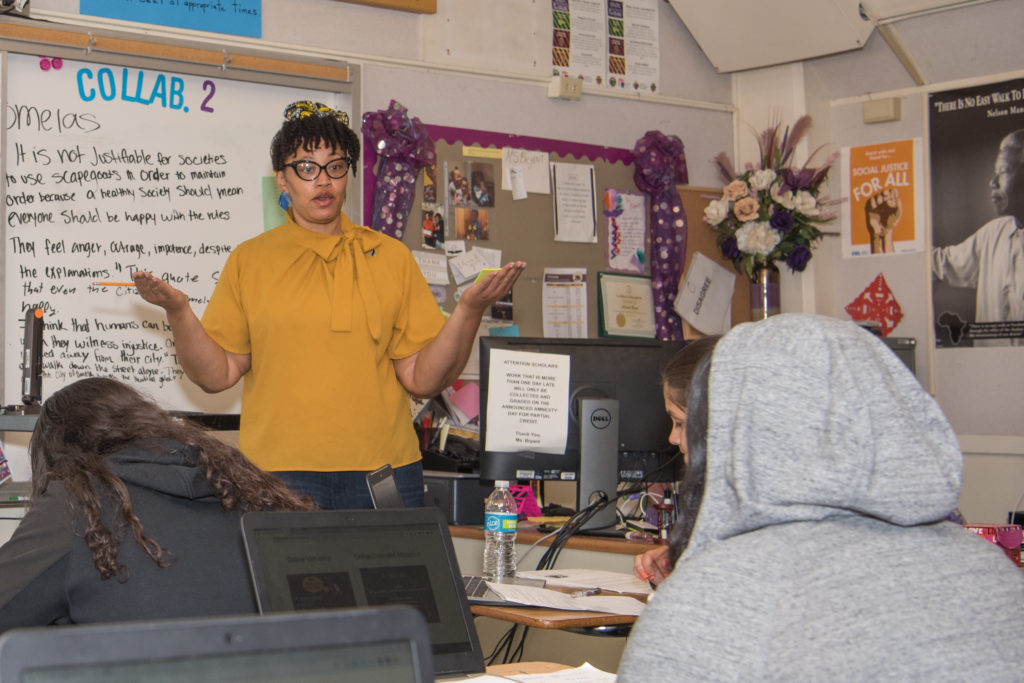Photos by Kim Sanford
Menlo Atherton High School teacher Sherinda Bryant takes a social justice approach to education. As a result, her ninth grade English students have won prizes, become critical thinkers and been a voice in their community.
Last school year, students received kudos for examining a
problem in their own backyard.
“We looked at the housing crisis and defined what it was,
why it was happening, and who benefits when there is a crisis,” says Bryant.
“We discussed very tough questions. But I was pleasantly surprised at the
responses I got from my 14-year-old students.”
Bryant teaches in Atherton, where even modest homes cost
millions. The Bay Area tech boom resulted in shortages of affordable housing,
displaced longtime residents and created a traffic nightmare.
The Sequoia District Teachers Association member expected
that her students from struggling families living in nearby Redwood City, Menlo
Park and East Palo Alto would worry their families are being priced out, but
conversations revealed broader concerns. Even students from affluent households
feared that after college, they would never be able to move back to their
community. Students worried about traffic, pollution, congestion and quality of
life.

When the Housing Leadership Council of San Mateo County
created a contest for youth to submit creative ideas about the housing crisis
last year, Bryant jumped at the opportunity. She made the contest an assignment
for her three freshman classes and submitted the best entries.
Students turned in artwork, poems and essays. At the awards
ceremony held in April at Kepler’s Books in Menlo Park, three won prizes: Marco
Lenzi wrote a song called “Housing Crisis Blues” that included video and news
reports; Clara Reinhold wrote a poem about the inequity of housing and what it
is worth to have a roof over one’s head; and Max Villalobos created artwork
with the message “Homes Are for People, Not Profit.”
“I was blown away,” says Bryant. “This was so much more than
just telling them facts so they could learn how to write. This project created
a platform for them to shine. At the awards night ceremony I just sat back,
watched and clapped.”
For Reinhold the experience was transformative.
“My teacher helped me figure out who I was. She helped me grow. I began focusing on social justice and became more interested in helping people. I joined school clubs such as Pride Pals, which includes students with special needs, and the Gay Straight Alliance. I became an ally.”
Our 2019-2020 Innovation Issue
Sherinda Bryant is one of the innovative educators we highlight this year. Meet the rest:
- Jennifer Barry guides Special Ed students in work and life skills
- James Gensaw helps Native American youth connect to their culture
- Somphane Hunter creates community in the kitchen
- Daniel & Dennis Gibbs set a STEM career path for students
- Becky McKinney builds relationships; students learn NGSS along the way
- Juan Padilla‘s big idea brings science opportunity to all kids
- Jorge Perez creates an oasis of scientific excellence at community college
Bryant grew up in the Bay Area and worked for years as a paraeducator before enrolling in the College of Notre Dame’s credential program, which partnered with the Sequoia Union High School District, community groups and philanthropists to pay tuition costs for participants. She has been teaching for two years.
She recalls experiencing racism and insensitivity as a
student in the public school system. Her high school, for example, had “Slave
Day,” where students “bought” other students for a day of servitude, which
African American students found very offensive. She says when members of the
Black Student Union walked across campus to a meeting, it caused an “uproar”
among others who felt threatened. When she became an educator, she decided to
expand her freshman English students’ horizons and teach through a social
justice lens.
“I’m not an expert on social justice. I’m a lifelong learner
continuously learning new things. But whatever we are reading — such as The
Great Gatsby, for example — we find a way to talk about racism and justice
and social issues.”
She is an adviser for her school’s Black Student Union,
which voted to welcome nonblack students who are interested in being allies and
social justice advocates.
Presently, her 11th graders are working on what it means to
be American and looking at students who are privileged, struggling or
undocumented. Her ninth graders are reading short stories and making
connections to current social issues.
“Being led by my passion has made me innovative,” says Bryant. “I feel very lucky. It’s beneficial for students and helps me pursue my dream of becoming a social justice advocate in the workplace and community.”
The Discussion 0 comments Post a Comment